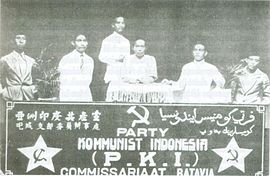Communist Party of Indonesia
| Communist Party of Indonesia | |
|---|---|

|
|
| Party leader | Henk Sneevliet |
| founding | 23 May 1914 |
| Headquarters | Jakarta |
| Alignment | Communism , Marxism-Leninism |
| Colours) | red |
| Number of members | 3 million (1960) |
| International connections | Communist International |



The Communist Party of Indonesia ( Malay Partai Komunis Indonesia , PKI ) was until 1966 in Indonesia was banned, the largest ever standing in government Communist Party .
history
In 1914, Henk Sneevliet founded the Indian Sociaal-Democratische Vereeniging (ISDV). It was through them that Marxist ideas entered the national independence movement of Indonesia.
In 1920 the ISDV took on the name Perserikatan Komunis di Hindia (PKH) and became the first communist party in Asia to join the Comintern .
In 1925 the executive of the Comintern demanded that the Communist Party of Indonesia (PKI) should form an anti-imperialist united front with non-communist parties. The attempt at revolution collapsed in 1926 and 13,000 people were arrested, 4,500 were imprisoned, another 1308 were interned and 823 were exiled to western New Guinea . The party was banned in 1927 and its members went illegally.
After the Japanese surrender in 1945, the party came out of illegality again. In February 1948 the PKI and parts of the left wing of the Indonesian Socialist Party formed a popular democratic front. In the 1950s Dipa Nusantara urged Aidit for a nationalist, anti-Western course by the PKI and support Sukarno . In 1951 Aidit was elected Chairman of the Politburo . Under Aidit, the PKI grew rapidly from around 4,000 members in 1950 to 165,000 in 1954 to 1.5 million members in 1959.
In the 1955 elections, the PKI still supported Sukarno's policies. It received 16% of the vote and 39 out of 257 seats.
In 1960 Sukarno propagated the slogan Nasakom , an abbreviation for Nasionalisme (nationalism), Agama (religion), Komunisme (communism). The PKI was thus established as Sukarno's junior partner. But she still took an independent course. The party newspaper Harian Rakyat criticized the government quite clearly in 1960, whereupon the leaders of the PKI were arrested but released again at Sukarno's personal orders.
In 1965, the PKI was the largest communist party outside the Soviet Union and China, with around two to three million members .
The end of the party
On September 30, 1965, there was a coup in which six leading generals of the Indonesian military were kidnapped and murdered. Details of the incidents are unclear. Although members of President Sukarno's army were involved, the communists were blamed for the incident.
This was followed by a massacre of members and supporters of the PKI and countless arrests without prior legal action. According to Amnesty International , between 500,000 and a million people fell victim to this wave of persecution. With that, the PKI lost its political power and communism was strictly forbidden both as a political movement and as a doctrine. To date, the PKI ban has not been lifted. The repeal is rejected not least by religious groups.
literature
- Jochen Hippler , Nasr Hamid Abu Zaid , Amr Hamzawy : War, Repression, Terrorism. Political Violence and Civilization in Western and Muslim Societies . ifa, Stuttgart 2006, pp. 55–58 ( review )
- JL Holzgrefe / Robert O. Keohane: Humanitarian Intervention: Ethical, Legal and Political Dilemmas . Cambridge (2003). ISBN 0-521-52928-X , p. 47
- Mark Levene et al. Penny Roberts: The Massacre in History . (1999). ISBN 1-57181-935-5 , pp. 247-251
- Robert Cribb, 'The Indonesian Marxist tradition', in CP Mackerras and NJ Knight, eds, Marxism in Asia (London: Croom Helm, 1985), pp. 251-272 [1] .
- Mortimer, Rex (1974). Indonesian Communism Under Sukarno: Ideology and Politics, 1959-1965 Cornell University Press, Ithaca, New York ISBN 0-8014-0825-3
- Ricklefs, MC (1982) A History of Modern Indonesia , MacMillan. ISBN 0-333-24380-3
- Sinaga, Edward Djanner (1960) Communism and the Communist Party in Indonesia , MA Thesis, George Washington University School of Government
Web links
- PKI 1914-1926 (English)
- Defense Speech by Sudisman 1967 (English)
- Shadow play
- http://www.massline.info/Indonesia/PKIscrit.htm
Individual evidence
- ↑ Thirdworldtraveler.com
- ↑ marxist.com
- ^ Anthony Reid: The Indonesian National Revolution 1945-1950 . Longman Pty Ltd, Melbourne 1973, ISBN 0-582-71046-4 , p. 83.
- ^ Communism and Stalinism in Indonesia. Workers' Liberty # 61, February 2000
- ^ Indonesians Go to the Polls: The Parties and their Stand on Constitutional Issues by Harold F. Gosnell. In Midwest Journal of Political Science May, 1958. p. 189
- ↑ An American estimate, however, only came to about 2 million. (Roger W. Benjamin, John H. Kautsky: Communism and Economic Development . In: The American Political Science Review . Vol. 62, No. 1. (March 1968), p. 122.)